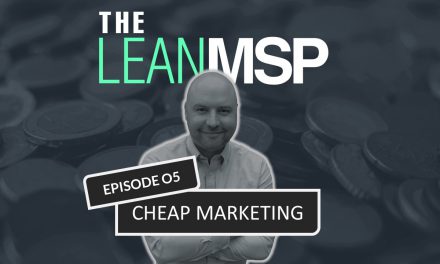Avoid These Budget Blunders When Advertising Your Managed IT Company
If you are serious about growing your Managed IT company, you are going to have to invest in generating leads through direct response advertising platforms. It is my opinion that with the precision of targeting that is available on digital advertising platforms (Google, Facebook, LinkedIn, Twitter, etc), the task of generating interest from Business Decision Makers has never been easier. Each platform has its quirks, but understanding what the quirks are and working around them offer the best opportunity for a consistent return on investment. Instead of letting you waste valuable ad spend learning the hard way, we documented some of the most wasteful practices we have seen that crush budgets and hurt ROI.
Not Segmenting Campaigns
The fewer campaigns you have, the easier it is to manage them. While this is true, it is not necessarily a recipe for a good return on your ad spend. The more campaigns you have, the more “levers” you have to control and adjust your bids. This gives you more flexibility in the way that your operate your campaign.
A good example of this would be in geographical targeting. You may be tempted to create a campaign that includes your entire service area. What you may not realize is that bids will vary greatly from one location to another. If your area includes a large city that has more competitive bidding, you may be overpaying for traffic outside of that city by not segregating the traffic in different campaigns.
Choosing The Wrong Bid Type
A monumental mistake that IT Marketers are making right now is not experimenting with different bid types on each platform. When first launching a campaign on a new platform you should always look to beat the minimum Cost Per Click. This is done by using one of the other available bidding options (CPM, CPV, etc). In some cases, launching the same ads to the same audience can cost you five to ten times more if you use the wrong bid type.
LinkedIn is the perfect example to describe this. When targeting Decision Makers on LinkedIn, the minimum they allow you to bid on a Cost Per Click basis is around $5.00 (USA). For this same traffic, the minimum CPM bid is usually around $17.00. This means that if you can achieve at least a 1% Click Thru Rate (which is fairly easy to do) then the click that would have cost you $5.00 on a CPC basis now only cost $1.70.
The Ultimate Guide To Cash Flow For Managed Services
Sponsored by Alternative Payments & Zest
Using “One Size Fits All” Creative
Now that you understand the value of CPM bidding and “beating the platform,” you are likely beginning to understand the importance of serving highly contextual creative to your audience. While it may be easy to simply create a few basic ads and run them for every campaign, you are sacrificing Click Thru Rate for time when you should be doing the opposite.
The best way to produce highly contextual creative is to make different ad sets for each Industry and Job Title. Segmenting your ad copy to include the Job Title of the audience will increase your CTR substantially. For example, let’s say you want to promote an article called 5 Steps To Identifying A Phishing Attack. If you are promoting this content to a group of CFOs, your ad copy could be “CFOs everywhere are shaken by the financial impact of phishing attacks. Take these 5 steps to prevent one from effecting your business.” Customizing the creative in this way takes only a few minutes but will pay dividends by increasing engagement.
Causing Fatigue By Over-Serving Ads
A common issue that can be difficult to identify is the over-serving of ads. If you are segmenting your audience, you are likely not targeting a very large group of people. In order to fulfill your budget, the advertising platform will show your ad to this same audience multiple times over. Eventually, everyone that would have clicked on your ad already has and impressions start to get wasted. If you let these ads run too long, your Click Thru Rate can drop, reaching the point of complete fatigue.
To prevent this, it is important to put new ads into your rotation every 30 days or when you see a significant drop in Click Thru Rate. Knowing when your ads are likely to fatigue and making changes ahead of the curve will save you significantly throughout the life of your campaigns. For easy identification, simply look at a line chart of your CTR and find the point in time where your CTR depreciates in the shortest period of time.
Letting Ads Run All Hours of Day
One thing to remember about marketing IT services is that your target audience is far less accessible outside of normal business hours. Since advertising platforms work off of a supply and demand system, this means that the best ROI is to be had when the most eyeballs (supply) are on the platform. If you are spending your budget at times when supply is low, you are going to have to pay more, which is likely to diminish your return.
The platforms clearly know this, which is why not all of them offer the ability to schedule your ads for certain hours a day. LinkedIn is the perfect example of this. Based on our experience, it appears that the best value for traffic occurs between 7am-12pm in your time zone. If you want to get the absolute most from your return, manually stopping and starting your ads outside of these hours is likely your best bet. Through our testing, we found that some CPM campaigns were seeing a 10% increase outside of these hours, as supply diminished and demand remained the same.
The Ultimate Guide To Cash Flow For Managed Services
Sponsored by Alternative Payments & Zest
Not Optimizing For Conversion
Another guaranteed way to throw away ad spend is by not optimizing for conversions. In order to run a successful campaign you must have an objective and a measurable result. Whether this is a subscriber to your newsletter, a request for a free quote, or a scheduling of an IT audit, you must be able to recognize who converted, how they converted, and why they converted in order to create a repeatable process.
One IT specific reason to optimize for conversion is that not every employee will have the same amount of buying power. In one of our previous examples, we described ad copy tailored specifically to a CFO. Through conversion optimization you may find out that CFOs do not convert well on the specific article or landing page that you are using even though the click cost is very affordable. A CEO may have higher click costs, but a lower cost per conversion, making it a better return on your ad spend. Always optimizing for the end result will ensure your best return in almost any circumstance.
Not Re-targeting Website Visitors
You have done the difficult work of finding someone that is interested in what you have to say and getting them to click to your website. At this point the failure rate is still extremely high. Even the best performing websites only convert a small fraction of visitors on the first visit. Even though the visitor didn’t act, that does not mean that they never will. This is why it is important to always re-target your visitors after they leave your site, drawing them back in to hopefully convert on the second attempt.
To do this you will need to create re-targeting audiences on all of the platforms you use. This is typically done by installing a code snippet on your site that tracks your visitors using cookies. After you have collected a large enough sample of visitors you can begin to run a new campaign to bring visitors back. You will likely find that this traffic converts higher than normal, lowering your overall conversion cost and making this a must-have component to supplement your campaigns.

SPONSORED BY ZEST

















